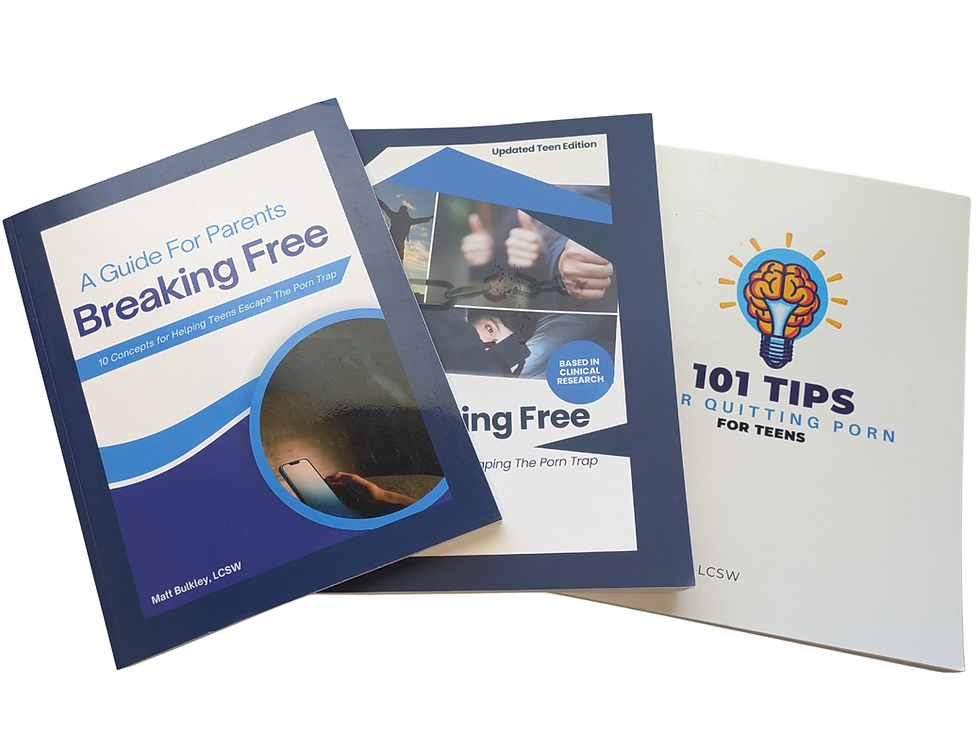Helping Your Teen Overcome Pornography Addiction: The Power of a Simple Walk
- Matt Bulkley

- Jun 27
- 4 min read
As a parent, watching your teen struggle with pornography addiction can feel overwhelming. You want to support them, but the path forward isn’t always clear. The good news? There’s a simple, science-backed strategy that can make a big difference: encouraging your teen to go for a walk when they feel tempted or stuck. This isn’t just a feel-good tip—it’s a practical tool rooted in research and clinical experience that can help your teen break free from the cycle of addiction. Here’s why it works and how you can guide your teen to use it.
Why Walking Works: The Science Behind It
Walking might seem too basic to tackle something as complex as addiction, but research shows it’s a powerful tool for resetting the mind. According to a 2019 study published in Health Psychology, a short 10-minute walk can significantly reduce stress and cravings in people battling addictions. For teens, whose brains are still developing and more prone to impulsive urges, this is especially effective. Walking acts like a “reset button,” calming the brain’s reward system and reducing the intense “I need it now” pull of pornography.
Beyond stress relief, walking helps teens shift their environment, which is critical for avoiding triggers. A 2020 report in Addictive Behaviors Reports highlights how changing physical surroundings—like stepping outside for a walk—can interrupt the mental patterns that lead to unhealthy habits. For a teen sitting in their room, where temptation might be just a click away, a walk creates a physical and mental break, giving them space to regain control.
The Emotional Boost: Walking for a Healthier Mindset
Pornography addiction often thrives on feelings of boredom, loneliness, or low mood, which are common in adolescence. Walking can counter these emotions naturally. A 2021 study in the Journal of Adolescent Mental Health found that teens who incorporated short walks into their day reported improved mood and a greater sense of control. When your teen walks, their body releases endorphins—natural chemicals that create feelings of happiness and well-being. These can compete with the fleeting rush of pornography, offering a healthier, more sustainable way to feel good.
Therapists who work with teens struggling with addiction often recommend walking as a go-to strategy. It’s not just about distraction; it’s about replacing a harmful habit with a positive one. By stepping outside, your teen can shift their focus from a screen to the world around them—fresh air, nature, or even just the rhythm of their steps. This simple act can help them feel empowered and less trapped by their urges.
Why Walking Is Perfect for Teens
One of the best things about walking is how accessible it is. Teens don’t need special equipment, a gym membership, or even a lot of time. According to a 2018 article in Psychology Today, low-pressure activities like walking are especially effective for teens because they’re easy to start and sustain. Therapists often hear from teens that a quick walk—whether around the block or to a nearby park—helps them feel like they’ve dodged a temptation and won a small victory. These small wins build confidence and momentum, which are crucial for long-term recovery.
Walking also gives teens a chance to process their thoughts without the pressure of sitting still or confronting their feelings head-on. For a teen who might feel embarrassed or overwhelmed talking about their struggles, a walk can be a low-stakes way to clear their head and regain perspective.
How You Can Help as a Parent
As a parent, you play a vital role in helping your teen adopt this strategy. Here are some practical ways to support them:
Encourage Without Pushing: Suggest walking as a way to “hit pause” when they feel tempted or stressed. Keep it positive—frame it as a way to feel better, not as a punishment or chore.
Model the Behavior: Go for walks together as a family or invite your teen to join you for a quick stroll. This normalizes the habit and creates bonding time without making it feel like an intervention.
Create a Trigger Plan: Work with your teen to identify their triggers—times, places, or emotions that lead to temptation. Suggest walking as a go-to response when those triggers arise. For example, “If you’re feeling bored after school, try walking to the park before getting on your phone.”
Celebrate Small Wins: Acknowledge when your teen chooses to walk instead of giving in to temptation. A simple “I’m proud of you for taking that step” can go a long way.
Make It Fun: Help your teen find ways to enjoy their walks, like listening to music, a podcast, or noticing something new in their neighborhood. This makes the habit more appealing and sustainable.
A Step Toward Freedom
Pornography addiction can feel like an overwhelming battle for your teen, but small, intentional actions like going for a walk can make a big difference. Science and clinical experience show that walking reduces cravings, boosts mood, and helps teens break free from the cycle of addiction. By encouraging your teen to lace up their shoes and step outside, you’re giving them a practical, empowering tool to take control of their choices.
So, the next time your teen feels stuck or tempted, remind them: a walk around the block or to a nearby park could be the first step toward a clearer mind and a stronger sense of self. You’re not just their parent—you’re their partner in this journey, and together, you can help them build healthier habits for life.
Where to Learn More
If you’re looking for additional resources or professional support, consider our resources for teens.










Comments